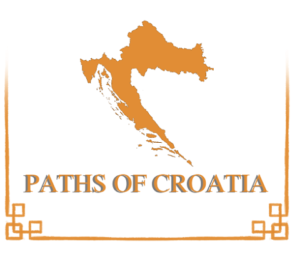Rijeka is a city with rich history and more than a few myths, legends, and truly fascinating real-life stories.
We decided to collect the best stories and fun and interesting facts that will attract you into exploring this beautiful, old port city.
From the legends of Dragons and pirates to monumental historical achievements and epic battle stories, you won’t leave uninterested.
So, let’s begin with the dragons, shall we?
The Legend of Dragons

You might hear from locals that at Trsat Castle you’ll find a statue of a dragon cast in bronze.
In other words, and more specifically, this statue represents a way more mythical creature than a dragon, it’s actually a basilisk, the rooster-headed monster with a dragon body and snake tail.
Back in medieval times, basilisks were considered dangerous monsters who were capable of delivering a fatal blow at first glance.
However, Trsat Basilisk was different, he cared about the citizens of Rijeka and would only harm those who tried to attack and break the piece.
Citizens were proud to have their personal guardian who lived in the cave up at Trsat Hill, which also allowed him to easily overwatch the town.
Routinely, the Basilisk would wake up early in the morning just as the first roosters do, jump out of the cave, and stretch its long wings over the sky above the town carefully examining the signs of enemies.
One day, his greatest enemy who wasn’t of human origins, but rather a giant octopus that inhibited the Mrtvi Kanal (the pool of water that stretches through the town) put its eyes on an innocent child.
The child was the daughter of the mayor of Rijeka, who loved to spend time drawing by Mrtvi Kanal.
The nasty sea monster planned the attack for days, as it hated the town’s citizens and wanted to rule over it as some sort of an elderly God.
When the giant octopus did the unspeakable and reached over the legs of the innocent child with its long tentacles, the overwatch Basilisk hurled down from the sky with tremendous speed and with a single breath delivered a massive fireblast that massacred the sea monster, while simultaneously reaching for the child and putting her below his great wing.
There are stories that later that or the next morning, the citizens of Rijeka feasted on roasted octopus for days.
Unfortunately, Basilisk soon realized that he grow too keen on people, which isn’t in their nature and as a matter of fact, could be dangerous for their species and thus decided to leave Rijeka once and for all the times venturing somewhere into the far lands across the sea.
How did the statue end up at Trsat? Well, the major of Rijeka later showed his gratitude to the magnificent creature who saved his daughter and the town from the enemy with a big bronze statue that realistically portrays Basilisk and speaks of its greatness.
The Titanic Connection
In 1912. the Carpathia ship began its journey from New York to Rijeka, but in the middle of the night, they received the SOS from Titanic.
Captain Arthur Henry Rostron reacted as quickly as he could, and by following the signal, the ship arrived to help the passengers an hour and 40 minutes after the Titanic sank.
As the first, big ship that arrived, the crew managed to save 712 passengers during the 4-hour-long rescue mission.
Unfortunately, the other 1459 passengers were forever lost in the cold abyss of the North Atlantic Ocean.
One-fourth of the crew that helped in the rescue was formed from Croatians, and one crew member important for this story was Giussepe Car, the sailor from Rijeka who after helping in the rescue managed to bring the Titanic life vest from the tragic night to Rijeka.

You can visit the Marine Life Museum in Rijeka and find the only preserved life vest from the Titanic tragedy in Europe.
The Legend of Morčić

The legend of Morčić is an integral part of the cultural heritage of Rijeka.
During the Middle Ages, Rijeka was frequently subjected to pirate raids from the Ottoman Empire.
These pirates would capture local inhabitants and take them as slaves and terrorize them.
Moreover, pirates thirsted for gold and tried to pillage the sea villages and towns at every opportunity.
This constant oppression grew as a great curse over Rijeka and someone needed to stop it, once and for all times.
One day, during the great Ottoman attack from the sea, The noble Croatian general Zrinski managed to hit the Ottoman leader with an arrow from miles away and make the Ottomans retreat in fear from such an unbelievable display of warfare skill.
This, of course, wouldn’t be possible for a mere human, but it is said that the whole day prior to the attack, the women prayed to God inside the doors, and thus God gave temporal superpowers to Zrinski.
Moreover, after the Ottoman pirates retreated, the women continued to pray that the rain of rocks fall from the sky and send the Ottomans into oblivion, so they shall never return.
And it was just as they prayed. Thousands of Ottoman soldiers were crushed beneath the rocks and only their white skulls remained intact.
Later, men created the jewelry in honor of their wives who with great prayer saved the nation from the dangerous pirates.
The legend further states that whenever the Morčić is worn with pride and respect, it serves as a talisman, protecting its wearer from harm and bringing good fortune. Today, the Morčić is still highly regarded in Rijeka, and it is often worn as a symbol of pride and cultural identity.
The Morčić has become an iconic motif in the city’s architecture, sculptures, and traditional costumes. It is also commonly used in various forms of art, crafts, and souvenirs, serving as a reminder of Rijeka’s history and a symbol of the fight against oppression.

Caroline of Rijeka

This is one of those stories the movies are made from, especially those worthy of Hollywood.
Caroline of Rijeka (Karolina Riječka), was a young 22 years old woman who lived in Rijeka, a daughter of the influential merchant and captain of Rijeka.
When in the 19th century the British navy arrived in Rijeka, the citizens thought it was yet another friendly visit.
However, it couldn’t be further from their real intentions as they showed when they fired a couple of hits from their cannons.
Out of despair, the minority of soldiers who protected Rijeka ran in fear surrounded by the cannon bombs, smoke, and fire that haunted him.
Then, all of a sudden, the young Caroline appeared through the smoke and approached the British soldiers whom she explained she wanted to see their commander.
And so she used her woman charm and diplomatic skills to persuade the British commander to spare Rijeka from further attacks.
In her glory, her citizens named the part of the port in her name and continued to tell stories about her great bravery, diplomatic and persuading skills, and charm that sealed protection over Rijeka and allowed beautiful years to come.
First torpedo
The first torpedo built in Rijeka, known as the “Luppis-Whitehead torpedo,” was a groundbreaking invention in naval warfare. It was the result of the collaborative efforts of two individuals: Giovanni Luppis, an Austrian naval officer, and Robert Whitehead, an English engineer.
In the mid-19th century, Giovanni Luppis, inspired by the American Civil War and the use of torpedoes in naval combat, began developing a self-propelled torpedo. Luppis served in the Austro-Hungarian Navy, which had its main naval base in the port city of Rijeka (then known as Fiume).
Luppis designed a prototype for the torpedo, which he called the “coastal defense system.” However, he faced challenges in realizing his vision due to limited financial resources and technical knowledge. It was at this point that he approached Robert Whitehead, an engineer from England who was known for his expertise in steam engines and shipbuilding.
In 1864, Luppis and Whitehead formed a partnership to develop and improve the torpedo. Whitehead brought his engineering skills and financial support to the project, allowing for the construction and testing of the first operational torpedo.
The Luppis-Whitehead torpedo consisted of a cylindrical body, propelled by compressed air and powered by an engine located in the rear. It was equipped with a warhead and a simple guidance system to ensure its direction.
In 1866, the torpedo underwent successful trials in Rijeka’s harbor, demonstrating its effectiveness as a naval weapon.

The Luppis-Whitehead torpedo marked a significant advancement in naval technology, revolutionizing underwater warfare. Its success in Rijeka laid the foundation for the development of modern torpedoes, which played a crucial role in naval conflicts and shaped naval strategies in the years to come.
Today you can visit the ruins of the launching and testing gate, the facilities, and the monument to this historical moment in Mlaka, the region of the city.
European Cultural Capital 2020
In 2020, Rijeka was chosen for the European Cultural Capital under the slogan “The port of diversity”.
Indeed, Rijeka is likely the most diverse city in Croatia or at least one of the most diverse cities in the whole of Croatia.
Rijeka was always connected to the world via the port, and most trends would first arrive in Rijeka due to its strong sea infrastructure that membered sailors and guests from all over the world.
Rijeka was among the cities with the strongest alternative music scene back in the ’70s and ’80s, and the city that created the first wave of excellent Punk music.
This claim witnesses the fact that the first Croatian rock bend Uragani came from Rijeka in 1960 when Elvis was rocking the U.S. and changed the world music scene.
Besides its strong music scene, Rijeka was the first to accept art and fashion trends which only later got accepted throughout the rest of the state.
2020. was meant to be the year of Rijeka, and the whole city was ready and organized with massive events and artistic exhibitions, but unfortunately, it didn’t live long because the pandemic ruined everything.
